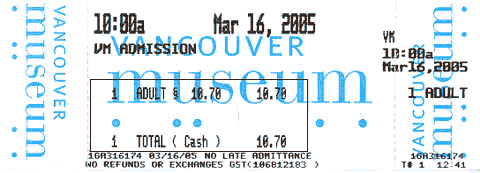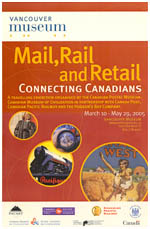
Articles

22
Images
To flip through all the images with this
article click on the camera to begin.
When you want to see the next image, click anywhere on the current
image.
|
|
Mail, Rail, and Retail is a
travelling museum exhibit featuring 150 artifacts on public display from 10 March
to 29 May 2005 at the Vancouver Museum. The exhibit illustrates how
Canada's postal service, rail transport, and retail commerce helped to shape the
nation we live in today. The displays also show the interdependence of these three
industries. They illustrate how the three sectors ensured each other's success.

Connecting Canadians
 This exhibit at the Vancouver
Museum tells the fascinating story of how mail, rail, and retail services developed
into crucial communication, transportation, and commercial networks across Canada's
vast expanse. Working together, these three sectors contributed greatly to the
country we live in today. This exhibit at the Vancouver
Museum tells the fascinating story of how mail, rail, and retail services developed
into crucial communication, transportation, and commercial networks across Canada's
vast expanse. Working together, these three sectors contributed greatly to the
country we live in today.
Mail by Rail
Starting in 1854, rail was used for the transport of mail, packages, gifts, and
moneybags. Specially designed cars served as mobile post offices with clerks sorting
the mail en route. There were all kinds of ingenious methods for ensuring speedy
delivery. For example, postal workers on trains picked up bags of mail with special
catch-post equipment while their trains were still moving. People could
even post letters through mail slots in the sides of special railway cars. The
mail-by-rail service ended in 1971 with the introduction of mechanized
mail sorting and the expansion of the national highway system.
A World of Goods
As Canadians became more urbanized in the late nineteenth and early twentieth
centuries, they began to buy more goods, rather than produce them themselves.
Retailers used the railways to transport products to postal offices in large cities
and small farming communities. Canadians across the country thus had access to a
world of goods, including the latest fashions, food, and household appliances.
Mail Order Catalogues
In 1884, the T. Eaton Company issued Canada's first mail order catalogue. The
Hudson's Bay
Company, Simpson's, and Woodward's soon followed with their own
catalogues. The mail order catalogue made it possible for anyone with mail service
or a nearby rail station to buy from the full range of a city store's products. This
thriving partnership between transportation, communication, and retail networks gave
people living in remote areas of Canada access to practically everything they might
want to buy.
Come on Over
More than three million immigrants came to Canada in the late nineteenth and
early twentieth centuries because of federal government efforts, in cooperation with
private-sector rail and retail interests. The federal government began
the advertising campaigns designed to attract European
immigrants to land available for settlement in Western Canada.
Companies like the Canadian Pacific Railway and the Hudson's Bay Company later
continued these campaigns, which included promotional pamphlets that tried to
downplay the effects of bitter Canadian winters.
Montreal: Canada's First Metropolis
The home of retail empires such as Dupis Freres and Morgan's, as well as an
important transportation and business center, Montreal was Canada's financial,
cultural, and industrial capital through out the nineteenth century and for most of
the twentieth. By 1911, Montreal's main post office had walls of marble, a tiled
mosaic floor, and an upper floor supported by huge pillars with classic capitals.
By the turn of the century, the city's Windsor Station had an elegant
five-arch open carriage way for passenger traffic, while Eaton's
ninth-floor restaurant featured and art deco design inspired by a
famous ocean liner.
The Insider View
Over the past 150 years, mail, rail, and retail services have employed thousands
of Canadians with diverse skills, from rail engineers to letter carriers to store
clerks. Railway mail clerks worked in dusty, jarring, and hot or cold conditions
depending on the season, but there were compensations in the strong sense of
camaraderie among workers. Railway firemen endured blisteringly hot conditions,
shovelling coal into boilers, but their jobs were often a stepping stone to becoming
an engineer.
Women at Work
Retail clerks were often women. Although they had little opportunity for
advancement, they enjoyed clean, comfortable surroundings, and the assurance of
steady employment. During the First and Second World Wars, women worked in jobs
formerly dominated by men, many of whom were fighting overseas. In the 1960s and
1970s, women started to break down old barriers and occupy positions from train
crew member to letter carrier to corporate executive.
Connecting in the Twenty-First
Century
Today, Canadians continue to benefit from the partnership
between mail, rail, and retail services. The growth of new technologies, including
electronic communications, and the Internet, are revolutionizing the way all three
services are delivered. This revolution builds on the story, begun in the 1850s, of
the three essential, interdependent sectors that have made it possible for Canadians
to connect throughout their nation's vast territory.
The Vancouver Museum - March 2005.
Associated Links
CPR web site - Mail,
Rail, and Retail: Connecting Canadians
Canadian Pacific Railway
Canadian National Railway
Vancouver Museum
Canadian Postal Museum
Hudson's Bay Company
Canadian Museum of Civilization

|
|